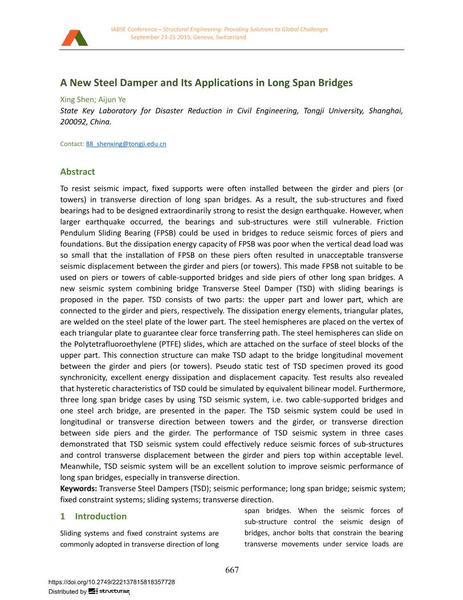|
Abstract:
|
To resist seismic impact, fixed supports were often installed between the girder and piers (or towers) in transverse direction of long span bridges. As a result, the sub-structures and fixed bearings had to be designed extraordinarily strong to resist the design earthquake. However, when larger earthquake occurred, the bearings and sub-structures were still vulnerable. Friction Pendulum Sliding Bearing (FPSB) could be used in bridges to reduce seismic forces of piers and foundations. But the dissipation energy capacity of FPSB was poor when the vertical dead load was so small that the installation of FPSB on these piers often resulted in unacceptable transverse seismic displacement between the girder and piers (or towers). This made FPSB not suitable to be used on piers or towers of cable-supported bridges and side piers of other long span bridges. A new seismic system combining bridge Transverse Steel Damper (TSD) with sliding bearings is proposed in the paper. TSD consists of two parts: the upper part and lower part, which are connected to the girder and piers, respectively. The dissipation energy elements, triangular plates, are welded on the steel plate of the lower part. The steel hemispheres are placed on the vertex of each triangular plate to guarantee clear force transferring path. The steel hemispheres can slide on the Polytetrafluoroethylene (PTFE) slides, which are attached on the surface of steel blocks of the upper part. This connection structure can make TSD adapt to the bridge longitudinal movement between the girder and piers (or towers). Pseudo static test of TSD specimen proved its good synchronicity, excellent energy dissipation and displacement capacity. Test results also revealed that hysteretic characteristics of TSD could be simulated by equivalent bilinear model. Furthermore, three long span bridge cases by using TSD seismic system, i.e. two cable-supported bridges and one steel arch bridge, are presented in the paper. The TSD seismic system could be used in longitudinal or transverse direction between towers and the girder, or transverse direction between side piers and the girder. The performance of TSD seismic system in three cases demonstrated that TSD seismic system could effectively reduce seismic forces of sub-structures and control transverse displacement between the girder and piers top within acceptable level. Meanwhile, TSD seismic system will be an excellent solution to improve seismic performance of long span bridges, especially in transverse direction.
|

